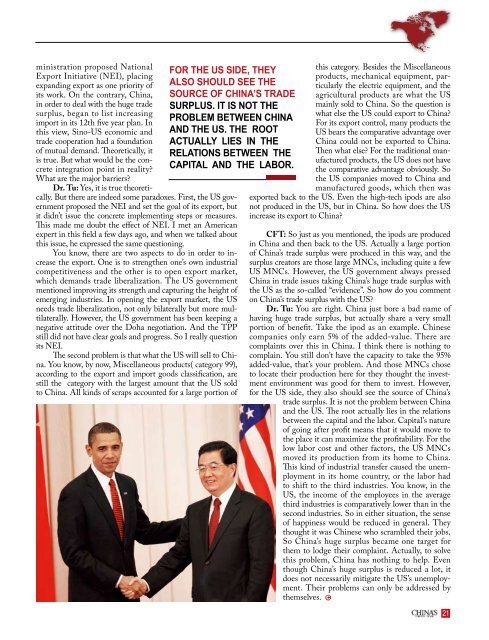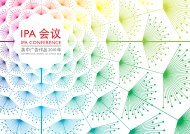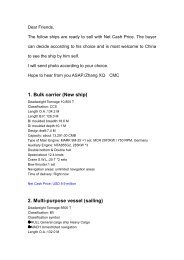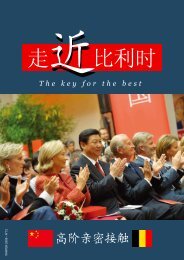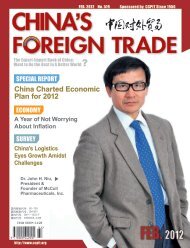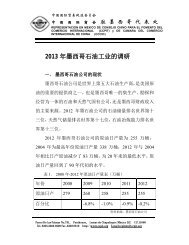Create successful ePaper yourself
Turn your PDF publications into a flip-book with our unique Google optimized e-Paper software.
ministration proposed National<br />
Export Initiative (NEI), placing<br />
expanding export as one priority of<br />
its work. On the contrary, China,<br />
in order to deal with the huge trade<br />
surplus, began to list increasing<br />
import in its 12th five year plan. In<br />
this view, Sino-US economic and<br />
trade cooperation had a foundation<br />
of mutual demand. Theoretically, it<br />
is true. But what would be the concrete<br />
integration point in reality?<br />
What are the major barriers?<br />
Dr. Tu: Yes, it is true theoretically.<br />
But there are indeed some paradoxes. First, the US government<br />
proposed the NEI and set the goal of its export, but<br />
it didn’t issue the concrete implementing steps or measures.<br />
This made me doubt the effect of NEI. I met an American<br />
expert in this field a few days ago, and when we talked about<br />
this issue, he expressed the same questioning.<br />
You know, there are two aspects to do in order to increase<br />
the export. One is to strengthen one’s own industrial<br />
competitiveness and the other is to open export market,<br />
which demands trade liberalization. The US government<br />
mentioned improving its strength and capturing the height of<br />
emerging industries. In opening the export market, the US<br />
needs trade liberalization, not only bilaterally but more multilaterally.<br />
However, the US government has been keeping a<br />
negative attitude over the Doha negotiation. And the TPP<br />
still did not have clear goals and progress. So I really question<br />
its NEI.<br />
The second problem is that what the US will sell to China.<br />
You know, by now, Miscellaneous products( category 99),<br />
according to the export and import goods classification, are<br />
still the category with the largest amount that the US sold<br />
to China. All kinds of scraps accounted for a large portion of<br />
FOR THE US SIDE, THEY<br />
ALSO SHOULD SEE THE<br />
SOURCE OF CHINA’S <strong>TRADE</strong><br />
SURPLUS. IT IS NOT THE<br />
PROBLEM BETWEEN CHINA<br />
AND THE US. THE ROOT<br />
ACTUALLY LIES IN THE<br />
RELATIONS BETWEEN THE<br />
CAPITAL AND THE LABOR.<br />
this category. Besides the Miscellaneous<br />
products, mechanical equipment, particularly<br />
the electric equipment, and the<br />
agricultural products are what the US<br />
mainly sold to China. So the question is<br />
what else the US could export to China?<br />
For its export control, many products the<br />
US bears the comparative advantage over<br />
China could not be exported to China.<br />
Then what else? For the traditional manufactured<br />
products, the US does not have<br />
the comparative advantage obviously. So<br />
the US companies moved to China and<br />
manufactured goods, which then was<br />
exported back to the US. Even the high-tech ipods are also<br />
not produced in the US, but in China. So how does the US<br />
increase its export to China?<br />
CFT: So just as you mentioned, the ipods are produced<br />
in China and then back to the US. Actually a large portion<br />
of China’s trade surplus were produced in this way, and the<br />
surplus creators are those large MNCs, including quite a few<br />
US MNCs. However, the US government always pressed<br />
China in trade issues taking China’s huge trade surplus with<br />
the US as the so-called “evidence”. So how do you comment<br />
on China’s trade surplus with the US?<br />
Dr. Tu: You are right. China just bore a bad name of<br />
having huge trade surplus, but actually share a very small<br />
portion of benefit. Take the ipod as an example. Chinese<br />
companies only earn 5% of the added-value. There are<br />
complaints over this in China. I think there is nothing to<br />
complain. You still don’t have the capacity to take the 95%<br />
added-value, that’s your problem. And those MNCs chose<br />
to locate their production here for they thought the investment<br />
environment was good for them to invest. However,<br />
for the US side, they also should see the source of China’s<br />
trade surplus. It is not the problem between China<br />
and the US. The root actually lies in the relations<br />
between the capital and the labor. Capital’s nature<br />
of going after profit means that it would move to<br />
the place it can maximize the profitability. For the<br />
low labor cost and other factors, the US MNCs<br />
moved its production from its home to China.<br />
This kind of industrial transfer caused the unemployment<br />
in its home country, or the labor had<br />
to shift to the third industries. You know, in the<br />
US, the income of the employees in the average<br />
third industries is comparatively lower than in the<br />
second industries. So in either situation, the sense<br />
of happiness would be reduced in general. They<br />
thought it was Chinese who scrambled their jobs.<br />
So China’s huge surplus became one target for<br />
them to lodge their complaint. Actually, to solve<br />
this problem, China has nothing to help. Even<br />
though China’s huge surplus is reduced a lot, it<br />
does not necessarily mitigate the US’s unemployment.<br />
Their problems can only be addressed by<br />
themselves.<br />
21


